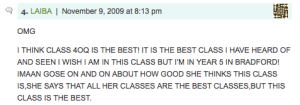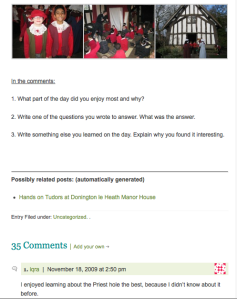For some time now Robin Hood School has been working on developing the use of blogging in the classroom, and the abundance of class blogs was something which attracted me to the school in the first place. In our school every class has their own blog, which is set up by the ICT co-ordinator with an account for each teacher. The blogs are used to different degrees and purposes by different staff, and they have primarily been used for reporting events that are significant to each class, as a way of sharing what they are doing with parents, each other, and the world. This purpose has been very successful, with the blogs given prominence on the front page of the school website, and a significant number of hits.
I strongly feel that tools such as blogs should be used to extend learning, rather than just to teach children the skills of ‘blogging’, so after using our blog for a few weeks I took a step back and evaluated what it was I really wanted them to get out of using the tool. I decided on two main purposes for our blogging. The first was to provide an audience for our work, much as had been done before, but focusing on sharing the work itself rather than just reporting on it. I strongly believe in the social constructivist notion of authentic learning, that is that children should be provided with real experiences in order to allow them to bring meaning to what they are doing in school and create true understanding. On a practical level, producing a piece of work for a real audience is likely to encourage more motivation, and hopefully deeper thinking as a result of wanting to produce the best finished product.
The second thing I wanted the blogs to achieve was reflection from the children. Talking about the lack of time for reflection in the current packed curriculum is becoming something of a cliche, but it is true that meaningful reflection is not an easy thing to accomplish with primary age children. Blogging should be a tool that encourages this, as it allows the posting of an item or idea, and asynchronous reflection on it through the medium of comments.
Objectives set, I began by expanding what we were sharing in the blogs from photographs and reporting of ‘events’ to specific pieces of work which the class have produced. I also emphasized the authenticity of the work we were doing by sharing with them the hit count, and promoting the blog on my own twitter feed to encourage some comments from outside of our school community.The children were thrilled with comments on work such as their Tudor dance from people outside of the school. They have also been using it to show parents and family what they have been doing at school. We have even also had comments from children at other classes in our school, and even from cousins who attend other schools in different parts of the country.
I then used the blog with the class as a whole to reflect on the work. Rather than accessing it from what was stored on my own computer I showed them where they could find it online, and modeled the process of reading, evaluating and commenting by transcribing their oral evaluations as comments on the blog. This encouraged lots of children to start looking at the blog in their own time, something which I think was helped by the setting up of our class website, which they seem to really feel ownership of.
We shared lots of work, and used looking at the blog as a plenary or review activity in a number of lessons. Whilst the children were producing quite evaluative comments orally when discussing the posts in lesson time, their independent written comments were still lacking in any real focus. Therefore, I decided to start helping them to structure their responses by providing an ‘In the comments..’ activity with suggested focus for responses at the end of the blog posts. I introduced this this week with the post on our trip to a Tudor house, and set commenting on the blog as an activity in our History lesson on Wednesday.
This resulted in a terrific response, and saw our blog get 256 hits in a single afternoon. Each time we work on a web based activity in class it seems to inspire more pupils to continue the work after school and we have quite a number now who revisit our class work as soon as they get home. Granted, many of the comments left are not that evaluative, or even answering the questions, but I intend to spend some time reflecting on their reflections as a class, and I am excited to see how this develops as they evaluate and model reflection to each other.
Eventually I would like to expand this communal reflection to a more personalised reflection with the development of either learning journals or digital portfolios based on a blogging platform.
My first ideas was the development of learning journals, where the pupils would have their own blog (possibly private but shared with me, or our class) in which they could regularly record what they had been doing at school and what they had learned. The fact that we have 1 netbook per child in our class should make this very manageable, and could be very valuable in terms of encouraging them to evaluate their own learning and think more deeply about it.
The second idea was more in response to a problem than a point of learning. As we are starting to do more and more work using different web 2.0 tools as part of our school drive to utilize the entire web as a VLE, pupils work is increasingly scattered across different sites. The longer this continues the more likely it is that pupils records of learning and improvement which is served so well by traditional folders and exercise books could be lost. As increasing numbers of these services allow users to embed their work in other sites and tools, a blog could be a powerful way of collating the work pupils do across different tools into one place. This would allow us to replicate the strength of exercise books in keeping a record of learning, but could also encourage reflection as children could return to older work to comment and evaluate, bringing to it their later learning.
Perhaps a hybrid of the two is what we really need, and I would be interested to see examples of how others may have used blogs in this way to help me come to a conclusion about where I am taking this next.
In many ways I think we are a long way from fully achieving what we can with the technologies we are using in terms of childrens learning beyond the world of ICT. However after a whirlwind half term getting to grips with my teaching and the abundance of ICT in our school I am starting to see where I need to go to develop what I am doing to achieve the enhancement of learning through technology I believe in.
With all of the superficial reports in the national press about children being ‘taught blogging’ and twitter instead of traditional subjects, I think it is ever more important to reflect on what we are trying to achieve with these tools. Given the pace of change in technology, the mechanics and etiquette of blogging may well be dead in a few years. However, if we can utilize these tools to provide children with transferable and valuable learning, such as the reflection and skills I have detailed here, then the effects of their use will far outlive their lifetime as a medium.
Links
Class 4OQ’s Blog – My class’ blog
Robin Hood blogs – Class blogs from our school
Porchester Junior School – Using blogs as digital portfolios
Digitalteacher.co.uk – Detailing the setup of the above.








 Posted by oliverquinlan
Posted by oliverquinlan